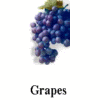 SKC Films Library |
| SKC Films Library >> Agriculture >> Plant Culture >> Fruit and Fruit Culture |
| Grapes Fossils of grape leaves and seeds indicate that humans have eaten grapes since prehistoric times. The cultivation of grapes appears in ancient Egyptian tomb paintings that date back to 2440 B.C.
A grape is a juicy, smooth-skinned berry that grows on a woody vine. Grapes grow in clusters of as few as 6 to as many as 300 berries. Berries may be black, blue, golden, green, purple, red, or white, depending on the variety of the plant. About 80 per cent of all the grapes grown around the world are used in making wine. About 13 per cent are sold as table grapes, which are eaten fresh. The rest are used, in order of importance, for drying into raisins, in making juice or jelly, and in canning with other fruits. Grapes have a high sugar content, which makes them a good source of energy. Most grapes are grown in Europe, with about 45 per cent of the world's supply coming from France, Italy, and Spain. California produces about 90 per cent of the grape crop of the United States. Other leading grape-growing states include, in order of rank, New York, Washington, Pennsylvania, and Michigan. Today there are more than 2,000 kinds of grapes. They have all come either from the wild grapes of the Near East or from those of North America. European grapes (Vitis vinifera) were brought to Mexico by Spanish adventurers of the 1500's. About 95 per cent of all the grapes grown in the world are European grapes. In the United States, these grapes are raised mainly in California. Growers classify the varieties as wine, table, or raisin grapes. Grapes native to North America consist of two main species: Vitis labrusca, also known as American bunch grapes; and Vitis rotundifolia, commonly called muscadine grapes. Both species can be eaten fresh or made into jelly or wine, but neither are used for raisins. American bunch grapes are grown chiefly in the northeastern states, along the eastern and southern shores of the Great Lakes, and in Washington. The most important variety is the Concord, used for jams, jellies and juices. Muscadine grapes grow throughout the southeast, from North Carolina to eastern Texas. The best-known variety, the Scuppernong, has medium-sized, bronze-colored berries. Muscadine grapes are widely planted, but mostly in small vineyards. Scientific Classification Division Magnoliophyta LINKS OF INTEREST SEE ALSO |
| SKC Films Library >> Agriculture >> Plant Culture >>
Fruit and Fruit
Culture This page was last updated on 09/21/2017. |
